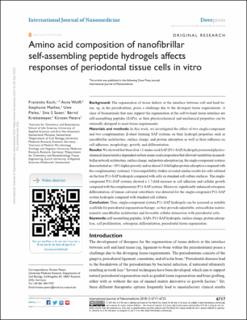Please use this identifier to cite or link to this item:
https://doi.org/10.21256/zhaw-27765| Publication type: | Article in scientific journal |
| Type of review: | Peer review (publication) |
| Title: | Amino acid composition of nanofibrillar self-assembling peptide hydrogels affects responses of periodontal tissue cells in vitro |
| Authors: | Koch, Franziska Wolff, Anne Mathes, Stephanie Pieles, Uwe Saxer, Sina S. Kreikemeyer, Bernd Peters, Kirsten |
| et. al: | No |
| DOI: | 10.2147/IJN.S173702 10.21256/zhaw-27765 |
| Published in: | International Journal of Nanomedicine |
| Volume(Issue): | 13 |
| Page(s): | 6717 |
| Pages to: | 6733 |
| Issue Date: | 2018 |
| Publisher / Ed. Institution: | Dove Medical Press |
| ISSN: | 1176-9114 1178-2013 |
| Language: | English |
| Subjects: | P11-SAP hydrogel; SAP; Cell proliferation; Osteogenic differentiation; periodontal tissue regeneration; Protein adsorption; Self-assembling peptide; Surface charge; Amino acid; Cell adhesion; Cell differentiation; Cells, cultured; Extracellular matrix; Human; Hydrogel; In vitro technique; Nanofiber; Neural stem cell; Osteoblast; Peptide fragment; Periodontium; Osteogenesis |
| Subject (DDC): | 610.28: Biomedicine, biomedical engineering |
| Abstract: | Background: The regeneration of tissue defects at the interface between soft and hard tissue, eg, in the periodontium, poses a challenge due to the divergent tissue requirements. A class of biomaterials that may support the regeneration at the soft-to-hard tissue interface are self-assembling peptides (SAPs), as their physicochemical and mechanical properties can be rationally designed to meet tissue requirements. Materials and methods: In this work, we investigated the effect of two single-component and two complementary β-sheet forming SAP systems on their hydrogel properties such as nanofibrillar architecture, surface charge, and protein adsorption as well as their influence on cell adhesion, morphology, growth, and differentiation. Results: We showed that these four 11-amino acid SAP (P11-SAP) hydrogels possessed physicochemical characteristics dependent on their amino acid composition that allowed variabilities in nanofibrillar network architecture, surface charge, and protein adsorption (eg, the single-component systems demonstrated an ~30% higher porosity and an almost 2-fold higher protein adsorption compared with the complementary systems). Cytocompatibility studies revealed similar results for cells cultured on the four P11-SAP hydrogels compared with cells on standard cell culture surfaces. The single-component P11-SAP systems showed a 1.7-fold increase in cell adhesion and cellular growth compared with the complementary P11-SAP systems. Moreover, significantly enhanced osteogenic differentiation of human calvarial osteoblasts was detected for the single-component P11-SAP system hydrogels compared with standard cell cultures. Conclusion: Thus, single-component system P11-SAP hydrogels can be assessed as suitable scaffolds for periodontal regeneration therapy, as they provide adjustable, extracellular matrix-mimetic nanofibrillar architecture and favorable cellular interaction with periodontal cells. |
| URI: | https://digitalcollection.zhaw.ch/handle/11475/27765 |
| Fulltext version: | Published version |
| License (according to publishing contract): | CC BY-NC 3.0: Attribution - Non commercial 3.0 Unported |
| Departement: | Life Sciences and Facility Management |
| Organisational Unit: | Institute of Chemistry and Biotechnology (ICBT) |
| Appears in collections: | Publikationen Life Sciences und Facility Management |
Files in This Item:
| File | Description | Size | Format | |
|---|---|---|---|---|
| 2018_Koch-etal_Amino-acid-composition-of-nanofibrillar-self-assembling-peptide.pdf | 3.63 MB | Adobe PDF |  View/Open |
Show full item record
Koch, F., Wolff, A., Mathes, S., Pieles, U., Saxer, S. S., Kreikemeyer, B., & Peters, K. (2018). Amino acid composition of nanofibrillar self-assembling peptide hydrogels affects responses of periodontal tissue cells in vitro. International Journal of Nanomedicine, 13, 6717–6733. https://doi.org/10.2147/IJN.S173702
Koch, F. et al. (2018) ‘Amino acid composition of nanofibrillar self-assembling peptide hydrogels affects responses of periodontal tissue cells in vitro’, International Journal of Nanomedicine, 13, pp. 6717–6733. Available at: https://doi.org/10.2147/IJN.S173702.
F. Koch et al., “Amino acid composition of nanofibrillar self-assembling peptide hydrogels affects responses of periodontal tissue cells in vitro,” International Journal of Nanomedicine, vol. 13, pp. 6717–6733, 2018, doi: 10.2147/IJN.S173702.
KOCH, Franziska, Anne WOLFF, Stephanie MATHES, Uwe PIELES, Sina S. SAXER, Bernd KREIKEMEYER und Kirsten PETERS, 2018. Amino acid composition of nanofibrillar self-assembling peptide hydrogels affects responses of periodontal tissue cells in vitro. International Journal of Nanomedicine. 2018. Bd. 13, S. 6717–6733. DOI 10.2147/IJN.S173702
Koch, Franziska, Anne Wolff, Stephanie Mathes, Uwe Pieles, Sina S. Saxer, Bernd Kreikemeyer, and Kirsten Peters. 2018. “Amino Acid Composition of Nanofibrillar Self-Assembling Peptide Hydrogels Affects Responses of Periodontal Tissue Cells in Vitro.” International Journal of Nanomedicine 13: 6717–33. https://doi.org/10.2147/IJN.S173702.
Koch, Franziska, et al. “Amino Acid Composition of Nanofibrillar Self-Assembling Peptide Hydrogels Affects Responses of Periodontal Tissue Cells in Vitro.” International Journal of Nanomedicine, vol. 13, 2018, pp. 6717–33, https://doi.org/10.2147/IJN.S173702.
Items in DSpace are protected by copyright, with all rights reserved, unless otherwise indicated.